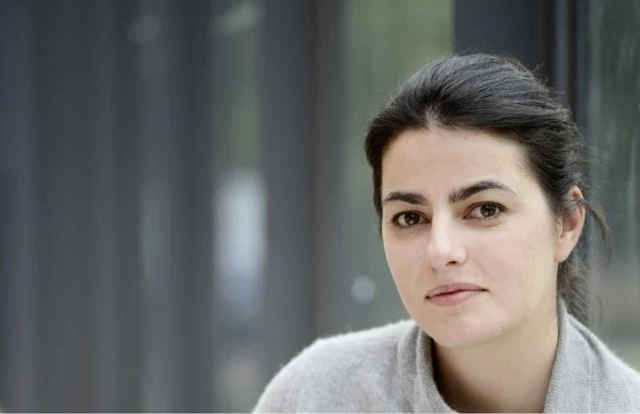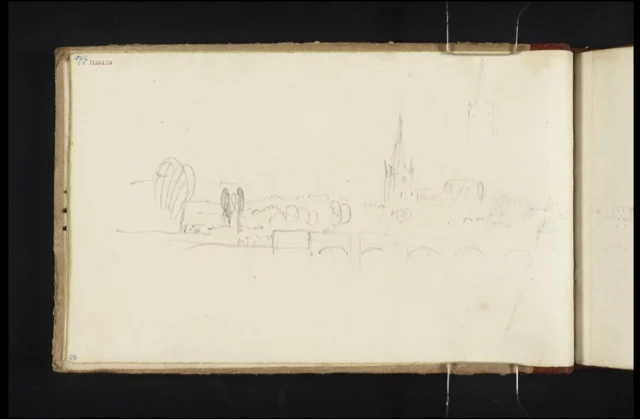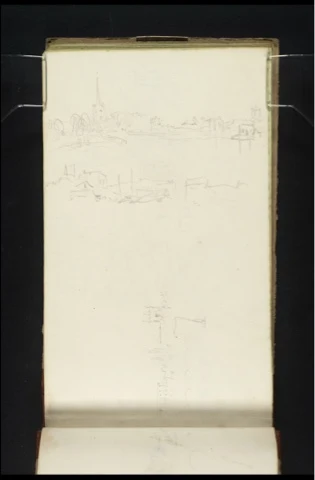Interview with Dobrinka Tabakova, Orchestra of the Swan’s award-winning Resident Composer (including Immortal Shakespeare – première: 21 April 2016)
– by Stephen, OOTS Writer in Residence
– by Stephen, OOTS Writer in Residence
I first came across Dobrinka Tabakova’s music just over eleven years ago: when Orchestra of the Swan (OOTS) gave the second performance of Bell tower in the clouds in Pittville Pump Room, Cheltenham. Back then, Dobrinka was still a music student; and, unbeknown to me, was actually sat in front of me and my young son. He commented, at the interval, on some of the technical aspects of the piece (harmonics in the cellos representing the bells, I think): and she was gracious enough to turn round and thank him. Even then, it was obvious from the orchestration – which was quite inspirational and innovative – as well as the emotion her music provoked – that here was a composer to watch; here was a composer who would go places.
It was therefore a great honour, just before Easter, to talk with her, over the telephone, about her music; and particularly the works she has written for OOTS.
Turner, Joseph Mallord William (1833 & 1836) © Tate, London 2015
From Val d’Aosta Sketchbook [Finberg CCXCIII], Four Sketches: Shakespeare’s Birthplace, Stratford-upon-Avon; Two Sketches Going up to the Col du Bonhomme; Boats on (?)Lake Geneva
(Graphite on paper; 113 x 190 mm)
From Val d’Aosta Sketchbook [Finberg CCXCIII], Four Sketches: Shakespeare’s Birthplace, Stratford-upon-Avon; Two Sketches Going up to the Col du Bonhomme; Boats on (?)Lake Geneva
(Graphite on paper; 113 x 190 mm)
The first thing that comes across is the immensity of her love of music. Having worked in music administration to support her studies – at the British Music Information Centre (now part of Sound and Music) – after completing her PhD (even though she had already produced successful commissions – such as Bell tower… (2004); and, later, Sonnets to Sundry Notes of Music (2006) – both of which were written for OOTS), she never stopped composing. As she advises me – and you can sense her smile as she does so… – “Keep your passion!”
Her enthusiasm is infectious; and our shared love of Shakespeare a great starting point. Although Sonnets to Sundry Notes… (which OOTS performed again, last year) includes “four songs using Shakespearean text taken from the collection The Passionate Pilgrim…” – and she had always believed that her collaboration with OOTS should involve such a setting of Shakespeare, she tells me that she finds setting any of his words “daunting”; that it is difficult to “venture into that world without some nervousness”.
Turner, Joseph Mallord William (1833) © Tate, London 2015
From Val d’Aosta Sketchbook [Finberg CCXCIII], Stratford-upon-Avon; Holy Trinity Church Looking over the Bridge
(Graphite on paper; 113 x 190 mm)
From Val d’Aosta Sketchbook [Finberg CCXCIII], Stratford-upon-Avon; Holy Trinity Church Looking over the Bridge
(Graphite on paper; 113 x 190 mm)
A few weeks ago, I was exceedingly fortunate to receive a copy of the orchestral score of her latest work for OOTS: Immortal Shakespeare. This is a “Cantata for choir and orchestra”, written to commemorate the four-hundredth anniversary of the Bard’s death. It will be premièred at a special concert in Holy Trinity Church – the “site of the Bard’s final resting place” – on 21 April 2016. (Dobrinka’s programme note for this can be found at the bottom of this post.)
Considering her pragmatic attitude to – and love of – Shakespeare, I asked her how she came to decide on the selections of his words (in effect, extended quotations from the plays) to set to music: especially when confronted with the challengingly-large œuvre that they represent.
Her setting-off point – much to my delight – was Jaques’ “All the world’s a stage”, from As You Like It. This – and especially its reference to the “seven ages” of man; our lives’ “different stages”, their “metamorphosis” – drives what, on paper, appears to be “the clear and simple structure” of texts she strived for: encompassing the idea – the lifespan – of ‘humanity’. But, in trying to avoid as many of Shakespeare’s most famous lines as possible, she admits she initially struggled to settle on the words that drive this arc; or to have confidence in her selection. “I changed the text about seven times in the last six months,” she admits, ruefully. (It doesn’t show, though!)
It was Dominic Dromgoole, the retiring Artistic Director at the Globe, who helped restore that confidence: stressing that “Shakespeare can be anything you want him to be!” And, because “there are phrases that we still use today” in his works, the title of her new composition had to be Immortal Shakespeare…!
Turner, Joseph Mallord William (1833) © Tate, London 2015
From Val d’Aosta Sketchbook [Finberg CCXCIII], Two Sketches of the Church and Other Buildings at Stratford-upon-Avon
(Graphite on paper; 190 x 113 mm)
From Val d’Aosta Sketchbook [Finberg CCXCIII], Two Sketches of the Church and Other Buildings at Stratford-upon-Avon
(Graphite on paper; 190 x 113 mm)
I am probably biased in admiring her final selection, because of my love for Jaques. But there are also sections from The Tempest and Hamlet (both on, this year, at the RSC); King John and The Merchant of Venice (which have been on in Stratford-upon-Avon quite recently). And the music ends, not with Shakespeare’s own words, but with the memorial inscription in Holy Trinity: which, to me, is an inspired choice – especially considering the location of this first performance.
Stay Passenger, why goest thou by so fast?
Read if thou canst, whom envious Death hath plast
Within this monument Shakespeare: with whom
Quick nature died: whose name doth deck this tomb
Far more than cost: sith all that he hath writ
Leaves living art, but page to serve his wit.
Turner, Joseph Mallord William (1833) © Tate, London 2015
From Val d’Aosta Sketchbook [Finberg CCXCIII], Three Sketches at Stratford-upon-Avon
(Graphite on paper; 113 x 190 mm)
From Val d’Aosta Sketchbook [Finberg CCXCIII], Three Sketches at Stratford-upon-Avon
(Graphite on paper; 113 x 190 mm)
Before we talk, Dobrinka emails me, telling me that “It has been a long journey, spanning about four years, to get the clarity of the structure and all the text passages” – and I now understand why. Later, she adds that “It takes such effort to bring a piece into the world: it is therefore very important that it is performed.”
Fortunately, she has a strong track-record, here – not only with many repeat performances of her work – but a landmark disc, String Paths – “This first full album devoted to [her] music” – which is utterly gripping, entrancing, and, in many ways, quite invigorating.
The pieces on the CD are obvious evolutions of the great combination of imaginative orchestration and deep feeling demonstrated in her earlier works for OOTS – and was therefore rightfully nominated for a 2014 Grammy. The stunning textures she weaves in those pieces – especially in the way she combines disparate sounds – are also apparent in Immortal Shakespeare – an obvious example being the harp harmonics, pizzicato violas, and sustained horn ‘beats’ that open the work.
In the String Paths sleeve-notes, she states that…
Performers give composers a voice. Without them, the pieces you write are just notes on a page. I love writing for specific performers, musicians I know. I trust that they believe in my music and sense the message of the compositions intuitively.
She also, in her writing, reciprocates that trust. The score of Immortal Shakespeare is testament to that. It plays to the Orchestra of the Swan’s many exquisite strengths; and yet – knowing how extremely talented they are – is a piece which “can be put together in one day”.
It will be a long day – with two extended periods of rehearsal – but an exciting, enthralling one, that is sure! The resultant concert, in the evening, will also be one that the audience recalls – and talks about – with joy, for many years to come.
Oh, and if you can’t make it in person, BBC Radio 3 will be recording and broadcasting it, the following Sunday evening (24 April), I believe.
Turner, Joseph Mallord William (1833 & 1836) © Tate, London 2015
From Val d’Aosta Sketchbook [Finberg CCXCIII], Two Sketches: Shakespeare’s Monument in Holy Trinity Church, Stratford-upon-Avon (with Inscription by Turner); Arvier in the Val d’Aosta
(Graphite on paper; 113 x 190 mm)
From Val d’Aosta Sketchbook [Finberg CCXCIII], Two Sketches: Shakespeare’s Monument in Holy Trinity Church, Stratford-upon-Avon (with Inscription by Turner); Arvier in the Val d’Aosta
(Graphite on paper; 113 x 190 mm)
Turner, Joseph Mallord William (1833) © Tate, London 2015
From Val d'Aosta Sketchbook [Finberg CCXCIII], Stratford-upon-Avon
(Graphite on paper; 113 x 190 mm)
From Val d'Aosta Sketchbook [Finberg CCXCIII], Stratford-upon-Avon
(Graphite on paper; 113 x 190 mm)
Immortal Shakespeare – Dobrinka Tabakova
Cantata for choir and orchestra
2016 (c. 30')
Prelude
I. Brave new world
II. To thine own self be true
III. Never doubt I love
IV. Be fire with fire
V/VI. Truth will come to light / All the world’s a stage
VII. Set me free
Postlude (Stay passenger)
The Immortal Shakespeare cantata brings together three artistic strands – words, visuals and music – in celebration of the timeless words of the Bard. Together with the words, an important source of inspiration for the project is a series of sketches made by JMW Turner on a visit to Stratford-upon-Avon in 1833, which I came across when researching this commission in 2011. The sketches can be arranged to form a journey from birthplace to resting place and on one of these Turner inscribes “The Immortal Shakespeare was born in this house”, which gave the title of this cantata.
The birthplace to resting place idea is mirrored in the choice of text, as I took Jaques’ famous monologue and compiled a selection of texts from Shakespeare’s plays which chart the seven ages of man: from Infant to Old Age. The final chorale sets the words on Shakespeare’s funerary monument at Holy Trinity Church, where the work will receive its première.
The work is commissioned by Orchestra of the Swan and Sorel Organization, with special gratitude to Tate Britain for permission to display some of the sketches and Dominic Dromgoole (Artistic Director, Shakespeare’s Globe) for his insightful guidance during the choice of text.
– D Tabakova: Programme note









No comments:
Post a Comment